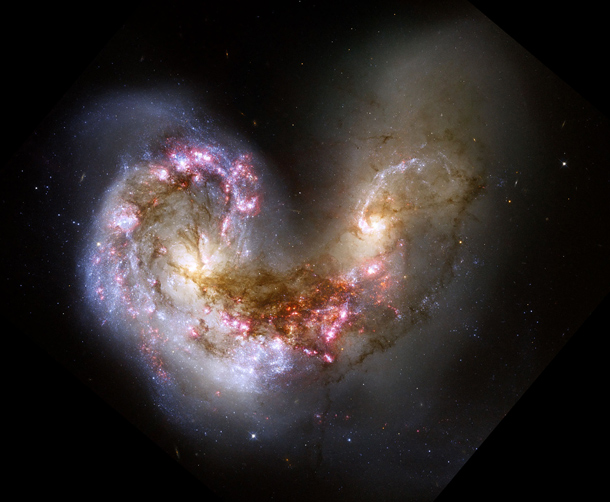We're open daily! View holiday hours
Science News
Valentine's Day
February 14, 2011

Happy Valentine’s Day from Science Today! In lieu of roses and chocolates, we’re offering you science news with a romantic twist!
Want loving space photos? Universe Today has a picture of a heart-shaped crater on the Moon—in 3D, no less; the Bad Astronomer offers several heart-shaped cosmic images on Discover; and be sure to check out a stunning image of a giant ring—not of jewels—but black holes from NASA’s Chandra X-ray Observatory.
No date tonight? NASA’s Stardust spacecraft will rendezvous with the comet Tempel 1 after 8:30pm our time, you can check out the whole thing live on NASA TV.
New Scientist has photos for Valentine’s Day that are a little more down to Earth. My favorite is #3, scavenger flies caught copulating… 20 million years ago! Talk about wrong place, wrong time—they were trapped in the act in tree resin.
Does nature limit the number of good-looking males a population can support? Unfortunately, yes, according to an article in today’s Proceedings of the National Academy of Sciences. A quick summary of the article in Science Now says that it’s just not sustainable:
Too many attractive males, and evolutionary pressures start to select against the best-looking… similar to how a male peacock’s large, colorful tail hinders its ability to flee and hide from predators.
Wonder if it’s true for females, too?
Despite the lover’s holiday, many corals will not be spawning tonight, according to new research in the Journal of Experimental Biology. UC Santa Barbara scientist Alison Sweeney found that a bluish twilight on evenings after a full moon may trigger mass spawning events among reefs. Science News reports that
…many corals manage to release their eggs and sperm into the water on one or just a few evenings of the year in the same few hours — sometimes just the same 20 minutes — as neighbors of the same species for miles around.
Timing is everything…
… Well, maybe not everything. How about place? Scientific American has a great graphic of where loves happens in the brain.
Finally, how about the Science of Kissing? It’s the title of science writer Sheril Kirschenbaum’s new book and answers some, if not all, of the following questions. Why do animals kiss? Why do we kiss? Can kissing ease allergies? What’s the history of human kissing?
With love.
Image credit: NASA, ESA, and the Hubble Heritage Team STScI/AURA)-ESA/Hubble Collaboration.